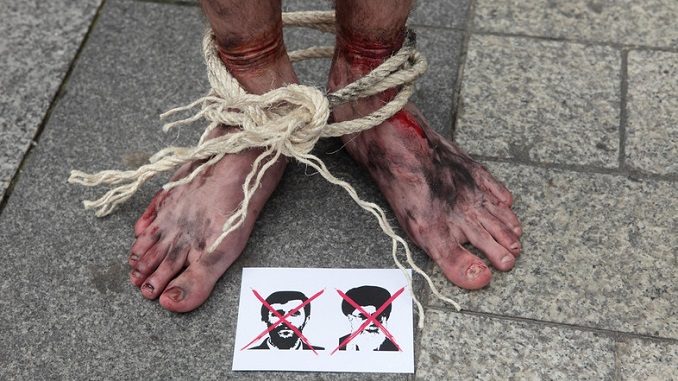
Just two weeks after the mass protests that rocked 130 cities across Iran ended, sources say, the rallies are back for round two but thousands of protesters remain illegally detained, Iran News Updates reports. The protests commenced on January 29 in Gorgan, the capital of Iran’s Golestan province. Thousands of protesters were videoed chanting, “Death to dictator” while they marched through the downtown streets. The protests have since spread to several cities, including Kerman, Shiraz, Arak, Isfahan, and Rasht.
The protests originated in response to the current economic situation in Iran coupled with a lack of social and political freedoms. Over 70 percent of Iranians live under the poverty line, according to a report published by Iran Focus.
While the new round of protests advances, many attendees fear for their safety after a large number of arrests that occurred in the previous weeks. Over 8,000 protesters remain in prison to date, according to Maryam Rajavi, the president-elect of the National Council of Resistance in Iran.
“Every day we hear of a new prisoner killed under torture while officials claim they have committed suicide. The regime must announce the names of all those arrested and all those killed under torture. They must account for those missing and if they have been murdered, the regime must announce where they have been buried,” she says.
“Many protesters have gone missing and the assumption is that they’ve been illegally detained,” said Ali Reza, an Iranian activist in France, in a recent interview. “Intelligence agents put pressure on their families not to speak to press, and out of fear they just keep quiet.”
Sepideh Farah Abadi, 29, and her family have been detained for over three weeks without access to a lawyer. Abadi was arrested on January 2, during protests in Tehran. Intelligence agents threatened her extended family, warning them that speaking to media wouldn’t be safe, according to an unnamed source inside Iran.
Sina Ghanbari, 23, was one of the protesters who died while being held in Tehran’s Evin prison. Authorities claim that Ghanbari committed suicide, but activists have disputed this claim and believe that prisoners are being force-fed pills that cause bodily harm.
Another Iranian protestor, Khalid Kayseri, who served 20 days in detention in Kermanshah prison died after being tortured by the intelligence service there, Iranian human rights groups have reported. This brings the number of demonstrators who have died in Iranian prisons to 11 since the start of the uprising on December 28.
The campaign ‘No Arrests and Executions’ said on their website that the Kurdish citizen was killed last Saturday, after being tortured and held in a secret detention where he was placed under investigation after his arrest in the popular demonstrations in Kermanshah. Police informed the family of his arrest and death after his 20-day detention.
The government claimed that Kayseri died from a drug overdose in prison, which is the same reasoning they used to cover the deaths of other demonstrators who were tortured and killed in prisons, the group added.
According to the group, Kayseri’s body was buried in his family’s attendance and a number of intelligence agents who imposed tight security around the cemetery of the city of Kermanshah. Since the beginning of the Iranian people’s uprising on December 28, 10 people died after being tortured in prisons, and 25 were shot dead by security forces during the protests. One of the demonstrators who was killed in prison was found in a river with visible torture marks on his body. Authorities left the body of another in front of his father’s home.
Iranian parliament member Ali Reza Rahimi had said that the authorities arrested about 5,000 people during the recent protests which took place in more than 100 cities in different parts of the country.
At least five protesters who were detained have reportedly died while in custody, according to a report released by Amnesty International. Relatives of those detained have reported that they’ve been unsuccessful in obtaining information about their loved ones and have faced intimidation and threats by authorities, says the report.
In response to the thousands of detained protesters, a social media campaign has emerged using the hashtag #FreeAllProtesters. The movement has spread across the Twitterverse, with people from Washington to Rome uploading their photos to Twitter with a sign requesting the immediate release of those arrested during the protests in Iran.
